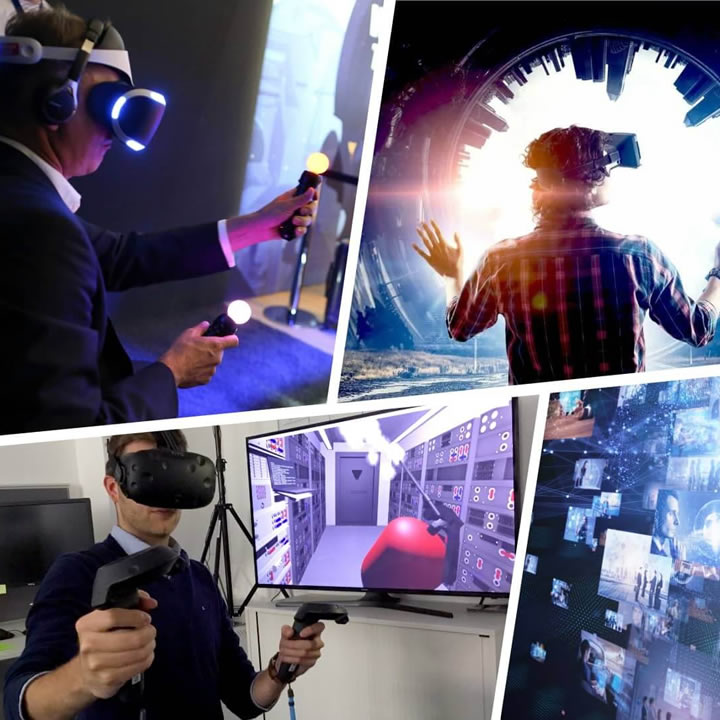In the 21st century, the convergence of cutting-edge technologies has given rise to an innovative concept known as RobotEra. This phenomenon is the harmonious fusion of blockchain technology and virtual worlds, promising to reshape how we interact with digital environments.
This initiative allows users to navigate and leverage the evolving digital landscape effectively.
In this article, we delve deep into the subject to explore the intricacies of RobotEra, its origins, implications, and potential applications. Start your trading journey by visiting a reliable trading platform like Enigma-Edge.
The Genesis of RobotEra
Origins of Virtual Worlds
Virtual worlds have come a long way since the inception of rudimentary text-based adventures.
They have evolved into intricate, immersive environments where millions of users interact daily. The journey began with early virtual spaces like Second Life and has progressed to the vast metaverse of today.
Evolution of Blockchain Technology
Blockchain technology, initially developed to underpin cryptocurrencies like Bitcoin, has matured into a robust ecosystem of its own. Its decentralized nature, cryptographic security, and smart contract capabilities have expanded its potential far beyond digital currencies.
Convergence of Virtual Worlds and Blockchain
The synergy between virtual worlds and blockchain became apparent as developers sought solutions to persistent issues in virtual environments. Blockchain’s ability to establish trust, enable digital asset ownership, and facilitate decentralized governance made it an ideal companion for the virtual realm.
Understanding Virtual Worlds
Definition and Characteristics
Virtual worlds are digital, interactive environments that simulate reality or create entirely fictional spaces. These environments often prioritize user engagement and can encompass various genres, from video games and social platforms to educational simulations.
Role of Virtual Worlds
Beyond entertainment and gaming, virtual worlds have found applications in fields such as education, training, therapy, and social interaction. They offer users a means to escape, learn, socialize, and even earn a living.
Challenges in Creating Immersive Virtual Environments
Constructing immersive virtual worlds is no small feat. Developers must overcome challenges related to realism, scalability, user interaction, and content creation to provide users with compelling and engaging experiences.
Blockchain Technology in RobotEra
Introduction to Blockchain Technology
Blockchain is a distributed ledger technology that records transactions across a network of computers. Its decentralized architecture enhances security, transparency, and tamper resistance. These features make it an attractive choice for virtual world developers.
Decentralization and Security in Virtual Worlds
In virtual worlds, decentralization helps prevent single points of failure, reducing the risk of server downtime or manipulation. This ensures the continuity of the user experience and enhances the security of in-game assets.
Smart Contracts and Their Role in Virtual Economies
Smart contracts, self-executing code on the blockchain, enable complex interactions in virtual economies. They facilitate automated transactions, ensuring fairness and transparency in in-game economies, such as trading virtual assets or conducting in-world business.
NFTs and Ownership in Virtual Worlds
What are NFTs?
Non-fungible tokens (NFTs) are unique digital assets that represent ownership of a specific item or piece of content. NFTs have gained prominence as a means of certifying ownership and authenticity in virtual worlds.
NFTs as Digital Assets in RobotEra
RobotEra leverages NFTs to represent in-game items, virtual real estate, and even characters. These NFTs grant players true ownership of their digital possessions, allowing them to trade, sell, or showcase them both within and outside the virtual world.
The Concept of True Ownership in Virtual Worlds
True ownership, enabled by NFTs and blockchain technology, empowers players to have control over their in-game assets. This concept shifts the paradigm from users merely having licenses to digital items to owning them outright.
Building and Governing RobotEra
Creating a Virtual World Ecosystem
Developers are tasked with crafting entire ecosystems within virtual worlds, including economies, social structures, and governance models. Blockchain technology plays a pivotal role in maintaining the integrity of these ecosystems.
Governance Models in RobotEra
Various governance models, including decentralized autonomous organizations (DAOs), enable users to participate in the decision-making process. Users can have a direct say in the development and evolution of the virtual world, fostering a sense of community and inclusivity.
User Participation and Decision-Making
Blockchain-based governance empowers users by allowing them to propose, vote on, and implement changes within the virtual world. This participatory approach can lead to more inclusive and responsive virtual environments.
Challenges and Future Prospects
Scalability Issues in Virtual Worlds
As virtual worlds grow in complexity and user base, scalability becomes a significant challenge. Blockchain solutions must evolve to accommodate the increasing demands of these immersive environments.
Ethical and Legal Concerns in RobotEra
RobotEra raises ethical questions about digital property rights, privacy, and the blurred lines between virtual and physical realities. Legal frameworks must adapt to address these emerging issues to ensure user protection.
Future Developments and Innovations in the Blockchain Era
The future of RobotEra holds the promise of even greater innovation. Improved scalability, enhanced graphics, and novel use cases are on the horizon, making virtual worlds an increasingly integral part of our digital lives.
Real-world Applications of RobotEra
Beyond Gaming
RobotEra’s impact extends far beyond the realm of gaming. Industries like education, healthcare, and virtual tourism are leveraging these immersive environments for training, therapy, and exploration.
Use Cases and Success Stories
Several notable projects have already demonstrated the potential of RobotEra. From virtual real estate sales to virtual art galleries, these use cases illustrate the diverse applications of this groundbreaking technology.
The Potential for Education, Healthcare, and Social Interaction
RobotEra has the potential to revolutionize education by providing interactive and immersive learning experiences. In healthcare, it offers therapy and rehabilitation options. In the realm of social interaction, it provides opportunities for people to connect and interact in novel ways.
Conclusion
In conclusion, RobotEra represents the convergence of virtual worlds and blockchain technology, offering users true ownership, decentralized governance, and innovative experiences. As the technology continues to evolve, its impact will extend into various industries, shaping the way we interact with digital environments.

